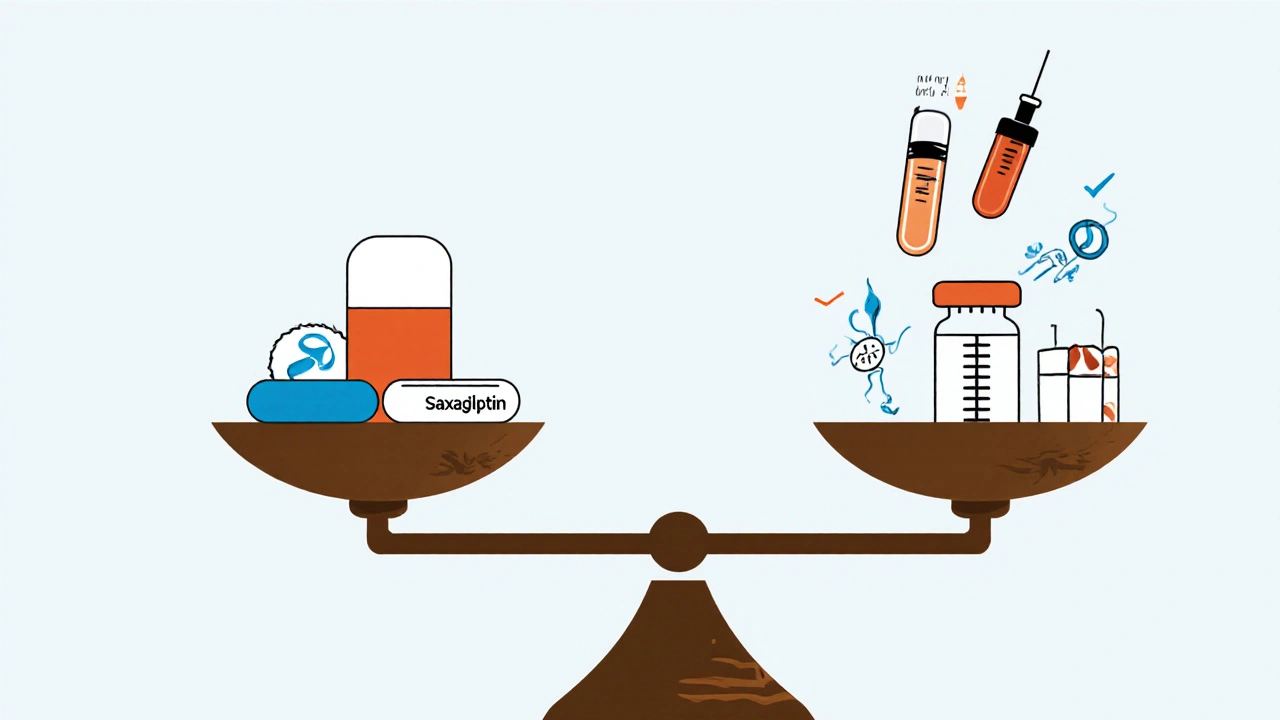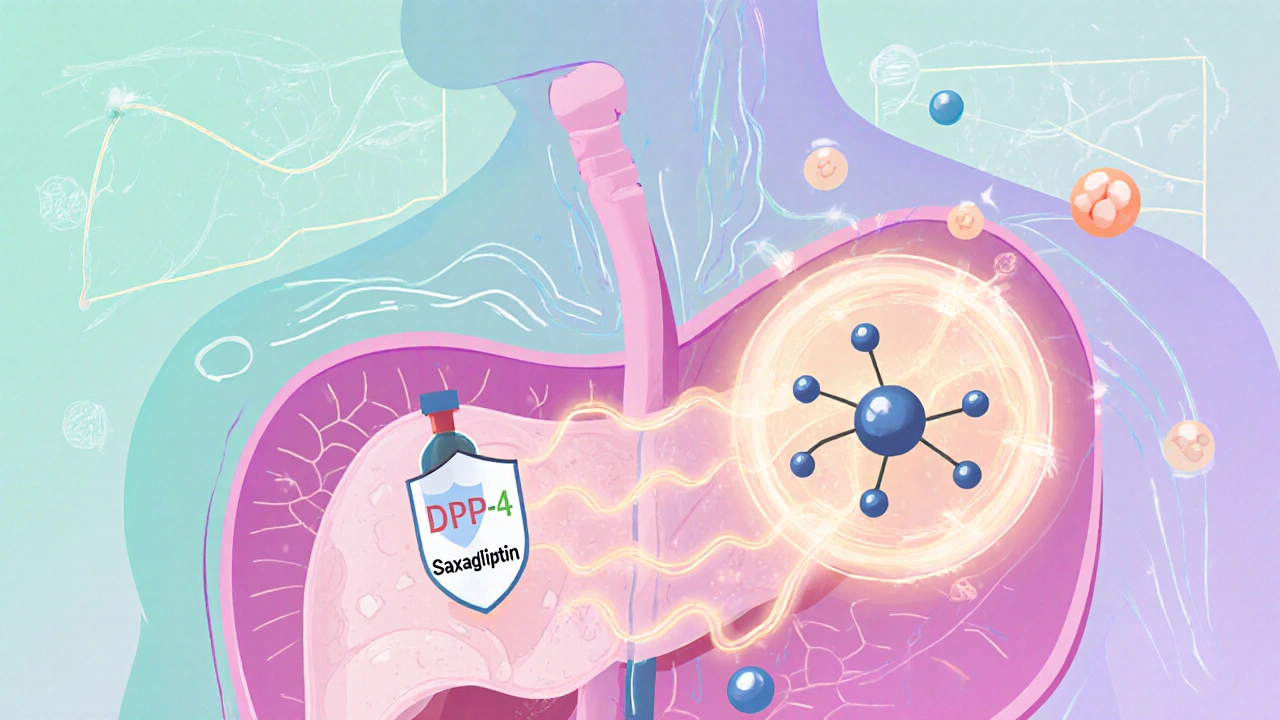Saxagliptin isn’t just another pill for diabetes. For millions of people with type 2 diabetes, it’s changing how they manage their blood sugar-without the weight gain, the low blood sugar crashes, or the daily injections that come with other treatments. Since it hit the market over a decade ago, saxagliptin has carved out a quiet but powerful role in diabetes care. It doesn’t force the body to produce more insulin. Instead, it helps the body use what it already makes-more efficiently.
What Saxagliptin Actually Does
Saxagliptin is a DPP-4 inhibitor. That’s a mouthful, but here’s what it means in plain terms: your body naturally makes a hormone called GLP-1 that tells your pancreas to release insulin after you eat. But an enzyme called DPP-4 breaks down GLP-1 too fast. Saxagliptin blocks DPP-4, so GLP-1 sticks around longer. That means more insulin gets released when you need it-and less when you don’t. The result? Smoother blood sugar spikes after meals and fewer highs and lows throughout the day.
Unlike older drugs like sulfonylureas, saxagliptin doesn’t push your pancreas to pump out insulin regardless of your blood sugar level. That’s why it rarely causes hypoglycemia on its own. In clinical trials, patients taking saxagliptin alone had hypoglycemia rates similar to those taking a placebo. When combined with metformin, the risk stays low-under 5% in most studies.
How It Compares to Other Diabetes Drugs
When you look at the options for type 2 diabetes, saxagliptin sits in a sweet spot. It’s not as strong as GLP-1 receptor agonists like semaglutide, which can lead to major weight loss and heart protection. But it’s also not as risky as insulin or sulfonylureas, which can drop your blood sugar dangerously low.
| Medication | How It Works | Weight Effect | Hypoglycemia Risk | Dosing |
|---|---|---|---|---|
| Saxagliptin | Blocks DPP-4 enzyme to boost GLP-1 | Neutral | Low (when used alone) | Once daily |
| Metformin | Reduces liver glucose, improves insulin sensitivity | Weight loss | Very low | Once or twice daily |
| Sulfonylureas (e.g., glimepiride) | Forces pancreas to release insulin | Weight gain | High | Once or twice daily |
| GLP-1 agonists (e.g., semaglutide) | Mimics GLP-1 hormone directly | Significant weight loss | Low (unless combined with insulin) | Weekly injection |
| Insulin | Replaces body’s insulin | Weight gain | High | Multiple daily injections |
For someone who’s tried metformin but still struggles with post-meal spikes, saxagliptin is often the next logical step. It’s taken as a pill, doesn’t require dose adjustments based on meals, and fits easily into a daily routine. It’s also one of the few diabetes drugs that can be used safely in people with mild to moderate kidney problems-unlike metformin, which often needs to be stopped if kidney function drops too low.
Who Benefits Most from Saxagliptin?
Not everyone with type 2 diabetes needs saxagliptin. But for certain groups, it’s a game-changer.
- People who can’t tolerate metformin-those with stomach issues like nausea or diarrhea-often find saxagliptin much easier on the gut.
- Older adults benefit because the risk of low blood sugar is low, reducing falls and confusion.
- People with kidney disease can often stay on saxagliptin even when metformin is no longer safe. The dose is lowered to 2.5 mg daily if eGFR is below 45, but it doesn’t get pulled entirely.
- Those avoiding weight gain-unlike insulin or sulfonylureas, saxagliptin doesn’t make you gain pounds.
One 2023 real-world study of over 12,000 patients showed that those switched from sulfonylureas to saxagliptin saw a 22% drop in hypoglycemic events over six months-with no loss in A1c control. That’s not just a minor improvement. It’s a safety win.

Side Effects and What to Watch For
Saxagliptin is generally well-tolerated. The most common side effects are mild: stuffy nose, sore throat, or headaches. These usually fade after a few weeks.
But there’s one serious concern: pancreatitis. While rare, cases have been reported. If you develop severe, persistent abdominal pain that radiates to your back-especially with vomiting-you need to stop taking it and get checked right away. The FDA added a warning about this in 2013, but the actual risk remains very low-less than 1 in 1,000 patients per year.
Another small risk is heart failure hospitalization. A large trial called SAVOR-TIMI 53 found a slightly higher rate of hospitalizations for heart failure in patients taking saxagliptin compared to placebo-about 3.5% vs. 2.8%. That’s why doctors avoid it in people with a history of heart failure unless the benefits clearly outweigh the risks. If you’ve had heart failure before, your doctor will likely choose another option.
How It Fits Into Modern Diabetes Care
Diabetes treatment today isn’t about one magic pill. It’s about stacking tools that work together. Saxagliptin doesn’t replace metformin-it complements it. In fact, the most common way saxagliptin is used is in combination with metformin, under brand names like Kombiglyze XR.
It’s also often paired with SGLT2 inhibitors like empagliflozin or dapagliflozin. These drugs help the kidneys flush out sugar through urine, while saxagliptin helps the body use insulin better. Together, they offer better A1c control, weight loss, and heart protection-without the insulin shots.
Guidelines from the American Diabetes Association now list DPP-4 inhibitors like saxagliptin as a second-line option after metformin, especially when weight gain or hypoglycemia is a concern. For patients who need something more than metformin but aren’t ready for injections, saxagliptin is often the bridge.
Cost and Accessibility
Brand-name saxagliptin (Onglyza) can cost over $500 a month without insurance. But generic versions are widely available now and often cost less than $10 per month at major pharmacies like Walmart or CVS. Many insurance plans cover it at Tier 1 or 2, meaning low copays.
Manufacturer patient assistance programs also help those without insurance. AstraZeneca’s program, for example, offers free saxagliptin to qualifying low-income patients. It’s not perfect, but it’s more accessible than many newer diabetes drugs.
What’s Next for Saxagliptin?
Saxagliptin isn’t the newest drug on the block. But it’s still widely prescribed-and for good reason. It’s reliable, predictable, and safe for long-term use. Research continues to explore whether it might have benefits beyond blood sugar control, like reducing inflammation or protecting nerve cells.
One 2024 study looked at saxagliptin’s effect on early-stage diabetic neuropathy. After 12 months, patients on saxagliptin showed slower nerve damage progression compared to those on metformin alone. It’s early data, but it suggests saxagliptin might do more than just lower glucose.
As diabetes care moves toward personalized treatment, saxagliptin’s role is clear: it’s the quiet workhorse for people who need steady, safe, pill-based control-without the drama of insulin or the cost of GLP-1 agonists.
Can saxagliptin cure type 2 diabetes?
No, saxagliptin doesn’t cure type 2 diabetes. It helps manage blood sugar levels by improving how your body uses insulin. Diabetes is a chronic condition, and saxagliptin is a tool to control it-not reverse it. Lifestyle changes, like diet and exercise, are still essential.
Does saxagliptin cause weight gain?
No, saxagliptin is weight-neutral. Unlike insulin or sulfonylureas, it doesn’t cause you to gain weight. Some people even lose a small amount over time, likely because their blood sugar levels stabilize and they’re less likely to experience hunger spikes.
Can I take saxagliptin with metformin?
Yes, combining saxagliptin with metformin is very common and often more effective than either drug alone. The combination is available as a single pill called Kombiglyze XR. This combo helps lower A1c by an average of 0.8% to 1.2% more than metformin alone.
Is saxagliptin safe for older adults?
Yes, saxagliptin is often preferred for older adults because it has a low risk of low blood sugar and doesn’t require frequent dosing. The dose is lowered to 2.5 mg daily for those over 75 or with kidney issues, which keeps it safe and effective.
What happens if I miss a dose of saxagliptin?
If you miss a dose, take it as soon as you remember. But if it’s almost time for your next dose, skip the missed one and go back to your regular schedule. Don’t double up. Missing one dose won’t cause a big spike, but consistent use is key for long-term control.
Does saxagliptin affect kidney function?
Saxagliptin is processed partly by the kidneys, so your doctor will check your kidney function before prescribing it. If your eGFR is below 45, the dose is reduced to 2.5 mg daily. Unlike metformin, saxagliptin doesn’t need to be stopped entirely in mild to moderate kidney disease.
If you’re managing type 2 diabetes and looking for a pill that works without crashing your blood sugar or packing on pounds, saxagliptin deserves a serious look. It’s not flashy, but it’s dependable-and for many, that’s exactly what they need.





Comments
I've been on saxagliptin for 3 years now. No weight gain, no crashes, just steady numbers. My doc switched me from glimepiride after I had two hypoglycemic episodes in one month. Best decision ever. No drama, just works.
I read somewhere that DPP-4 inhibitors might increase pancreatic cancer risk? Is that true? I'm just worried now...
Oh. My. GOD. Another 'quiet workhorse' piece. 🙄 Look, saxagliptin is basically the pharmaceutical equivalent of a beige sweater-safe, boring, and utterly forgettable. Meanwhile, semaglutide is out here doing backflips while losing 30 lbs and reducing cardiovascular events. This article reads like an AstraZeneca press release written by a sleepwalker.
If you're struggling with metformin gut issues or scared of insulin spikes, give saxagliptin a shot. It's not magic but it's gentle. I helped my mom switch and she hasn't had a single dizzy spell since. You got this 💪
So... let me get this straight. You're telling me we have a drug that doesn't cause weight gain OR hypoglycemia... but it might cause heart failure? 😭 I mean, at this point I'm just gonna eat a donut and call it a day. 🤡
The clinical data supporting saxagliptin as a second-line agent in patients with renal impairment is robust and aligns with the American Diabetes Association's 2023 guidelines. Its pharmacokinetic profile permits dose adjustment without discontinuation, a significant advantage over metformin in the aging population with declining glomerular filtration rates.
I wonder if the fact that it doesn't force insulin release means it's more... respectful of the body's natural rhythm? Like, we're not yelling at the pancreas anymore, we're just whispering, 'hey, maybe now would be a good time?' It feels almost... philosophical.
Honestly I was skeptical but my mate in Manchester started it last year and his A1c dropped from 8.2 to 6.9 without any side effects. Now he's biking every weekend. Who knew a little pill could give you your life back?
Let’s be real - if you’re still on oral meds in 2024, you’re not managing diabetes, you’re just delaying the inevitable. GLP-1s are the future. Saxagliptin is just the diabetic version of a flip phone - it works, but why are you still using it?
The SAVOR-TIMI 53 trial was a disaster. 3.5% heart failure hospitalization? That’s not 'slightly higher' - that’s statistically damning. And the fact that this is still prescribed to elderly patients with comorbidities is medical malpractice disguised as 'conservative therapy'.
America spends billions on this stuff while other countries use cheap generics. We’re being scammed. Metformin is 99% effective and costs $4. Saxagliptin? $10? That’s corporate greed. This isn’t science - it’s capitalism.
I just started this and already feel so much better 😊 no more 3pm crashes! Also my nails are stronger?? Maybe it’s the sugar control?? 🤷♀️💖
i took this for 2 weeks and my head hurt and i felt like a zombie. i stopped. now i just eat less sugar and its fine. why do we need all these pills?
i switched to saxagliptin after metformin gave me diarrea 24/7. its been 8 months. no side effects. my doc said its good for my kidneys too. thanks for the info in the post, really helped me decide.
You’re telling me this is the 'quiet workhorse'? I’ve seen more personality in a toaster. At least a toaster gives you toast. This thing just sits there like a depressed accountant. 🧍♂️📉